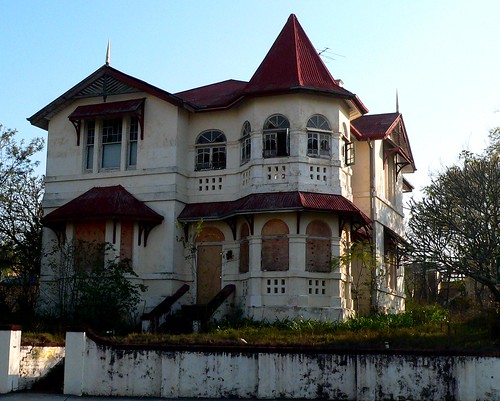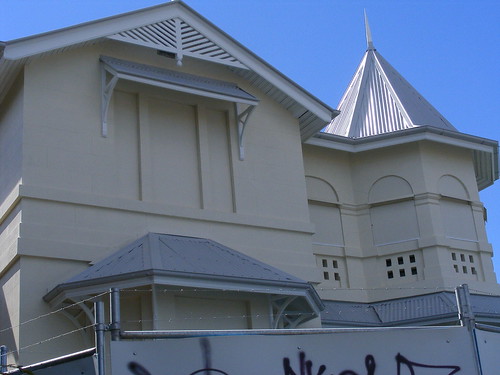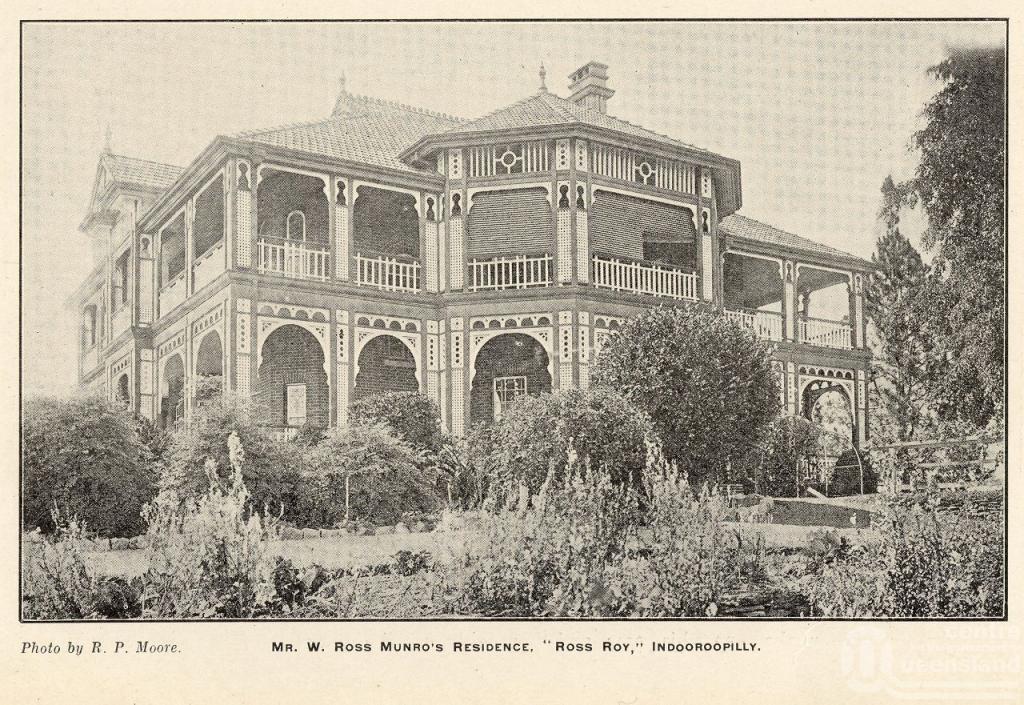
[Previous Post: Western Australian Federation Heritage Sites 2... Next Post: ]
Table of Contents
Indooroopilly, Brisbane suburb, Queensland
Indooroopilly is liberally sprinkled with old mansions, and none better reflects the grandeur of the suburb's salad days than Ross Roy.| Picture of Indooroopilly residence, Ross Roy, ca. 1929 |
Ross Roy later became the heart of St. Peter's Lutheran College when the school opened in the 1940s
- To capture the essence of Indooroopilly of those times, let's quote from an anonymous tribute written about 1890:
- "The district comprises a series of sharp ridges and gentle slopes, giving continual glimpses of the river, and the purple shrouded hills to the south and west, which have a wondrous charm. The switchback, tree lined streets are bordered with handsome residences and still more handsome gardens which, even in the hollows, give distinction to the district." -http://www.nswholidays.com.au/qld/brisbane-west-indooroopilly-8L2685.html
The area now known as Indooroopilly was surveyed in 1858 and first settled in 1860. The area was subdivided into farms and later into residential allotments. Prior to 1870 there were few houses built in the area but settlement of the district received impetus from the opening of the Brisbane to Ipswich railway in 1875. During the 1880s and 1890s Indooroopilly developed as a fashionable suburb. Many substantial, architect-designed residences were built on large allotments.

The Brisbane Courier Saturday 15 August 1931:
- "INDOOROOPILLY was slow of expansion until recent years (the greatest development took place within the past 10 or 15 years), but the tardiness of its growth is no fault of the suburb or of its pioneers. Indeed, it is a remarkable tribute to both that the place advanced as it did, in spite of the want of adequate transport.
- Population followed the tramline in other parts of Brisbane, and Indooroopilly was at a disadvantage until the advent of good roads. One beneficial effect of this restrained progress, however, is that Indooroopilly was spared the crowding that some other suburbs experienced, and retains its fresh garden atmosphere.
- For a long time Indooroopilly was an unwon area between two classes of property that were then much in demand - city lands on the one hand, and generous flats, suitable for dairying, on the other. And that is why, as late as the early 1890's, tents could be seen pitched on what are now Indooroopilly's main thoroughfares, when other parts of the future city were well-founded. Until the time came when Brisbane's growth demanded the start of closer suburban settlement Indooroopilly was the home of a few only, who selected it for its rural charms and its salubriousness. There they found a picturesque spot, not far from town - a fine place, situated high enough to dispel fear of floods, but near enough to the winding river to make it arresting to the eye of the beauty lover.
|
|
Beautiful Homes
THIS favoured place was chosen later by many keen and far-sighted men and women as the location of beautiful and substantial homes, which stand there to-day.- Finney's Hill over- looks Witton Manor, a stately old place on the river bank, which was once the home of Mr. Andrew Bogel.
- Mr. Graham Hart's fine home, Greylands, was built in 1876,
- and Mr. H. C. Stanley, railway chief, also had his home in the locality.
- Mr. E. M. Long, a sugar planter, of Mackay, owned a house on the river bank, below where Mr. Morrow now lives, and it was occupied by the late Mr. J. F. G. Foxton before he built The Priory, another grand old house, erected near the railway bridge, and now the property ot Mr. B. F. Cribb.
- Forty-four years ago the home of Mr. W. H. Hart, solicitor, and son of Mr. Graham Hart, was built by Mr. Hunter, an architect. The late Mr. J. R. Newman, solicitor, had his house constructed at Indooroopilly in the early '80's. It was destroyed by fire not long ago.
- Then there is the imposing dwelling that used to be known as Warranoake, the home of Mr. Gilson Foxton, which

was bought by the Catholic Church five and a half years ago, and is now a convent for the Brigidine Sisters. It stands on an eminence at the corner of Church and Cecil streets, in four acres of land. - Another well-known place is Ross-Roy, the home of the Ross-Munro family,
- While the home of Mr. L. J. Keating, on Westminster-road, was constructed to the design of the late Mr. Richard Gailey, and is considered to be one of the outstanding examples of residential architecture in Brisbane. It was built by Mr. Keating's grandfather, the late Mr. L. Stamm, about 35 years ago, and used to be occupied by the late Dr. Hawkes, Mr. H. R. Boer (at one time Attorney-General), Mr. T. Daley, solicitor, and other prominent citizens.
- Mr. Keating's mother, Mrs. J. Coonan, who cut up a lot of her property at Indoroopllly into estates and sold it, lives in another historic pile, Stamford House.
- Those which have been mentioned are typical of the class of houses that sprang up in the suburb from its earliest days, and are sufficient proof of its residential qualities.
|
| ||||
|
|
Indooroopilly's State Heritage mansions
| Greylands | State Heritage | 47 Dennis Street | INDOOROOPILLY |
| Keating Residence, Indooroopilly | State Heritage | 10-12 Westminster Road | INDOOROOPILLY |
| Tighnabruaich | State Heritage | 203 Clarence Road | INDOOROOPILLY |
Belvedere c1886 (destroyed)
Belvedere's history
- The two blocks of land were bought in 1880 for £210 by Ebenezer Hooker who in 1888 sold to John Lawry, the accountant in Queensland's Postmaster General's Department.
- He built the house and called it "Bandarra", then "Belvedere" and in 1901 sold it to the Klinger family, who called it "Carlner". The family kept it for 20 years as one of Brisbane's most distinguished homes.
- In 1921 it was sold to Charles Hamilton and Louisa Vaughan who renamed it "Devon".
- In the 1930s and 1940s it was converted into smaller flats and units. The name "Belvedere" still appears above the lower-level windows.
- The South Brisbane house that inspired Australian writer David Malouf was to be restored and not demolished, drawing a three-year legal battle to a close.
- Brisbane City Council opposed the Greek Community's application to have the 125-year-old Belvedere building at 27 Edmonstone Street demolished in 2010.[1]
History lost
Local residents, who gathered in Musgrave Park opposite the building, said they were disappointed to see one of Brisbane's oldest homes destroyed.- "We've lost a big piece of history here," said one West End resident, who requested not to be named.
- "It went up very quickly. The flames were twice the height of the building. It was very scary."
- He said squatters had long been in and out of the building. "Security at the building hasn't been great," he said.
- Conservation architect Peter Marquis-Kyle said he was deeply saddened by the fire.
- "There has been a long running campaign by the community to protect this very house," he said.
- "It is, or was, a very good example of the high class and middle class homes that used to surround this park."
- Lord Mayor Graham Quirk also expressed his disappointment.
- “In 2010 I stood outside this important part of Brisbane’s heritage and declared council would oppose any attempt to knock it down," he said.
- “It’s very sad news for the local community and the broader Brisbane community that this precious and historic building has been destroyed by fire."[2]
Greylands 1876
 |
| One of Brisbane’s grand and earliest villas built in Indooroopilly, Greylands was constructed in 1876 |
| The original portion of Greylands is a brick building, single-storeyed at the front and double at the rear. The plan is symmetrical about a wide hallway which features a central screen with double doors. Two rooms on the right are divided by a set of folding doors. On the other side of the hallway are two bedrooms. Joinery throughout is of cedar, and all fireplaces retain their mantelpieces of marble, grates and hearths. Floors in each room are edged in cedar. | In addition to its elegant exterior form, the house displays craftsmanship and detailing of a high standard including its cedar joinery and other interior decoration. Its appeal is enhanced by the retention of almost 5000 square metres of landscaped grounds which are free from urban intrusion. |
Keating House
- See also Federation Queen Anne style
 |  |
Indooroopilly's own "Monster House"15 May 2008 , 8:00 PM by Spencer Howson | Keating reborn in Brisbane08 January 2009 , 1:31 PM by Spencer Howson |
- It was built by Mr Keating's grandfather, the late Mr L. Stamm about 35 years ago and used to be occupied by the late Dr Hawkes, Mr HR Boer (at one time Attorney General), Mr T Daley, solicitor and other prominent citizens. It seems that Louis Stamm may never have lived in this house, as his residence is listed most often as at 25 Herbert Street, Spring Hill. Stamm was an early Chairman of the Indooroopilly Divisional Board when it separated from Taringa and Toowong.
- By 1885 Stamm retained only 10 acres of his original Indooroopilly allotment and this was mortgaged to Henry Love who subdivided it in the late 1880s. Stamm retained lots 71, 72 and 73 of Portion 46 and this transfer from Love was recorded in 1898.
- Stamm is thought to have built the house at about this time. The residence appears to have been leased to a number of people during the years from its construction to the 1920s when the Keating family moved there.
- During the 1920s or 1930s the house seems to have been extensively renovated. Much of the interior fittings and finishing of the present house, particularly on the ground floor, along with some external detailing appear to date from this period rather than from the late 1900s from which the shell of the house dates.
Ross Roy
- See also Federation Filigree style
 | |
 |
‘Ross Roy’ was constructed in 1897 to a design by Claude W. Chambers, as a residence for tea merchant Daniel Collings and family and named In. Passed to the Munros around 1910, it was given its current name and used as the family residence as well as the setting for several charitable functions. The house, with six acres of land, was sold to the United Evangelical Lutheran Church in 1945 and repurposed as a secondary Lutheran school. The Langer chapel, designed by important and influential architect Karl Langer, was built for the school in 1967-8. Both buildings have continued to be used by the St Peter’s Lutheran College, which has grown to become the largest co-educational Lutheran school in Australia.[4]
- "Though the formal decisions on Old Government House took place at the end of 1909, interestingly, the government had anticipated the need for a temporary Vice-Regal residence much earlier. ..."
- At least one more property was presented to the government in the first half of 1909 but, as the need to find a temporary residence became pressing towards the end of that year - linked, of course, to the decision about the University - the floodgates opened. Offers of suitably grand Brisbane homes that could be rented - or sold - came thick and fast. At least fifteen were brought to the government's attention - ‘Kinellan', ‘Wybenia' and ‘Merthyr' in New Farm - the last owned by Sir Samuel Griffith, who said he would accept 25,000 pounds for it - ‘Delamore' in Kedron, ‘Indoocombe' and ‘Greylands' in Indooroopilly, ‘Dryallwyn' in Towoong, ‘Garfield' and ‘Fernberg' in ‘Upper Paddington', ‘Cintra' in Bowen Hills, ‘Newstead House' (as Society members will no doubt know), ‘Toorak' in Hamilton, ‘Whitecliffe' in Albion, ‘Tarranalma' in Clayfield and ‘Cumbooquepa' in South Brisbane."[5]
Tighnabruaich
- See also Federation Queen Anne style
 |  |
- Tighnabruaich is a large, two-storeyed timber residence constructed c1889 for HC Stanley, Chief Engineer for Railways in Queensland, to a design by his brother, former Colonial Architect FDG Stanley. The place is important in demonstrating the pattern of growth of Brisbane, specifically at Indooroopilly, where middle-class suburban residential development was attracted to the district after the opening of the Indooroopilly Railway Station in 1875. As one of a group of substantial, late 1880s residences constructed in Brisbane, Tighnabruaich also contributes to our understanding of the nature of the Queensland economic 'boom' of this period.
- The property is significant for its association with allied interrogation of prisoners of war during World War II and, during the second half of the 20th century, as the showcase residence of officers commanding the Australian Army in Queensland.
- The building is a fine example of the mature domestic work of FDG Stanley and contributes to the body of knowledge about the work of this prolific and influential Queensland architect.
- The building has aesthetic value as a well-composed, picturesque residence influenced by Gothic revival architecture popular during the second half of the 19th century. It contributes to the townscape of Indooroopilly and is a landmark along the Brisbane-Ipswich railway.
- Tighnabruaich has a special association with the Australian Army as the residence of the generals commanding the Army in Queensland for close to half a century. Trees planted by resident generals remain as evidence of that association.-
http://www.yourbrisbanepastandpresent.com/2013/02/tighnabruaich-indooroopilly.html
- ^http://www.brisbanetimes.com.au/queensland/belvedere-building-saved-from-demolition-20130508-2j7tq.html
- ^ http://www.brisbanetimes.com.au/queensland/belvedere-building-to-be-bulldozed-after-fire-20131113-2xf43.html
- ^https://heritage-register.ehp.qld.gov.au/placeDetail.html?siteId=32441
- ^http://heritage.brisbane.qld.gov.au/heritage_register/placeDetail.do?action=read&placeId=2252&fullDetail=true&navParam=startBasic
- ^ http://www.govhouse.qld.gov.au/the_governor/100714_clem_lack.aspx










No comments:
Post a Comment